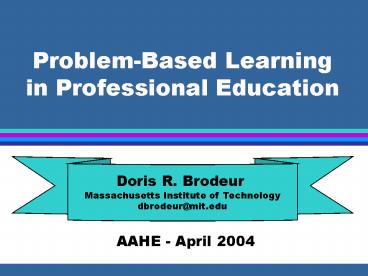ProblemBased Learning in Professional Education - PowerPoint PPT Presentation
1 / 35
Title:
ProblemBased Learning in Professional Education
Description:
Collaboration across disciplines, cultures, and countries. Outline. Relevance to conference theme ... Teamwork and collaboration. Project management. Self ... – PowerPoint PPT presentation
Number of Views:68
Avg rating:3.0/5.0
Title: ProblemBased Learning in Professional Education
1
Problem-Based Learning in Professional Education
Doris R. Brodeur Massachusetts Institute of
Technology dbrodeur_at_mit.edu
AAHE - April 2004
2
Professional Education
Medicine and Health Care
Business
Teaching
Law
Engineering
Architecture
3
Todays Objectives
Apply knowledge of PBL to your own professional
programs
Share ideas and experiences of PBL with other
participants
4
Outline
- Key features of PBL
- Relevance to conference theme
- Learning theories that underlie PBL
- Design of PBL experiences
- Assessment of PBL experiences
5
PBL Problem? Project? Performance?
Problem-Based Learning
Project-Based Learning
Performance-Based Learning
6
Student-centered and self-directed
- The Water Bike Project at
- The Royal Institute of Technology (KTH),
Stockholm
7
Organized around real-world problems
The SPHERES Project at MIT
8
Focused on authentic skills
9
Collaborative
10
With faculty as facilitators
Workshop at Queens University, Belfast
11
Pair-and-Share
- Your name, affiliation, and professional area
- Experience with PBL (is it problem, project, or
performance?) - Questions about PBL
12
Outline
- Key features of PBL
- Relevance to conference theme
- Learning theories that underlie PBL
- Design of PBL experiences
- Assessment of PBL experiences
13
Democratic Transformations
- Opportunities for students to organize their own
learning - Increased access to multiple sources of
information - Changing roles for faculty
- Collaboration across disciplines, cultures, and
countries
14
Outline
- Relevance to conference theme
- Key features of PBL
- Learning theories that underlie PBL
- Design of PBL experiences
- Assessment of PBL experiences
15
Constructivism
- What is learned is a function of the content,
context, activity of the learner, and goals of
the learner - Students build their own internal frameworks of
knowledge upon which they attach new ideas - Cognitive conflict is the stimulus for learning
16
Metacognition
- Knowing about knowing affects learning
- Students are encouraged to think critically and
monitor their understanding - Students reflect not only on what they know, but
on how they know it
17
Social Negotiation
- Social and cultural factors affect learning
- Knowledge evolves through social negotiation and
evaluation of the viability of individual
understandings - Collaboration promotes PBL
18
Outline
- Relevance to conference theme
- Key features of PBL
- Learning theories that underlie PBL
- Design of PBL experiences
- Assessment of PBL experiences
19
Pair-and-Share
- Describe a sample problem in your area
- List the key intended learning outcomes for this
PBL experience - Describe the learning environment
20
Designing Problems (1)
- Identify problems that raise the concepts and
principles relevant to the content domain - Anchor all learning activities to a larger task
or problem - Support the learner in developing ownership for
the overall problem or task
21
Designing Problems (2)
- Design an authentic task, i.e., one in which the
thinking required is consistent with the thinking
in the environment for which the learner is
preparing - Design the learning environment to support and
challenge the learners thinking - Design the task and environment to reflect the
complexity of the environment in which learners
will later function
22
Designing Problems (3)
- Encourage testing ideas against alternative views
and alternative contexts - Set realistic and assessable parameters
- Provide opportunities for reflection on both the
content learned and the learning process
23
Sequencing PBL Experiences
- The learning sequence is not necessarily the same
as the sequence of the process in the
professional environment - Sequence for levels of complexity in problem
structure, type of solution, number of people
required, length of time
24
Level of Complexity 1
- Structured problem
- Known solution
- Individual or group solution
- Same problem for all students
- Short time frame
25
Level of Complexity 2
- Structured problem
- Known solution
- Team solution
- Same problem for all teams
- Short time frame
Autonomous Robots at MIT
26
Level of Complexity 3
- Complex problem
- Solution can be known or unknown
- Team solution
- Different problem for each team
- Several weeks or months
Third-Year Electronics Project at Linkoping
University
27
Level of Complexity 4
- Complex problem
- Unknown solution
- Team solution
- Single problem solved by multiple sub-teams
- More than one term long
ARGOS Project at MIT
28
Pair-and-Share
- Discuss the levels of complexity and sequencing
of PBL experiences in your professional programs
29
Outline
- Relevance to conference theme
- Key features of PBL
- Learning theories that underlie PBL
- Design of PBL experiences
- Assessment of PBL experiences
30
Intended Learning Outcomes
- Content knowledge
- Reasoning and problem solving
- Oral and written communication
- Teamwork and collaboration
- Project management
- Self-directed learning
31
Assessment Methods
Observation with Rating Scale
Case Study Analysis
Self-Assessment with Rating Scale
Intended Learning Outcomes
Oral Questions and Interviews
Journals and Portfolios
Product Review with Rating Scale
32
Matching Assessment With Outcomes
33
Project Assessment
- Product Review
- Built to specification
- Time
- Team Collaboration
- Written Documentation
- Reflective Journal
Formula Student Project at Chalmers Institute of
Technology, Gothenberg
34
Project Assessment
- Product Review
- Built to specification
- Course completion
- Time
- Number of trials
- Team Collaboration
- Articulation of robot logic
35
Summary
- Key features of PBL
- Learning theories that underlie PBL
- Design of PBL experiences
- Assessment of PBL experiences
- QUESTIONS?































